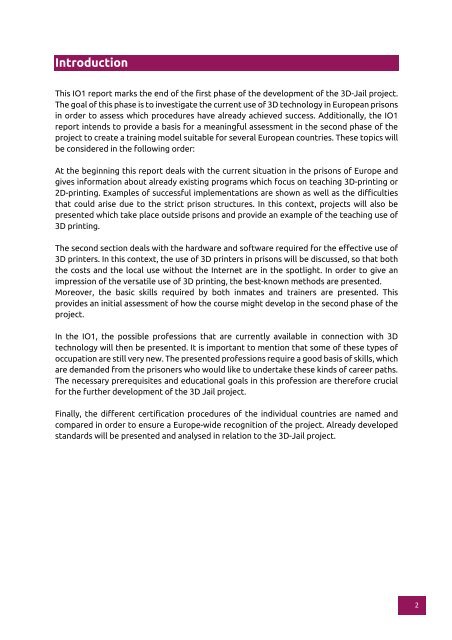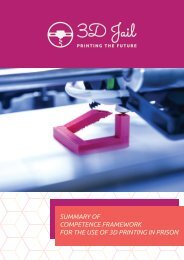3D Jail Project - IO1 - Competence framework for 3D printing in jail
Intellectual Output 1 The main innovative element of IO1 is to entail professionalizing competencies on the use of 3D printing technologies in the learning context of people with fewer opportunities because of their status of prisoners, ex-prisoners or subjected to alternative measures to detention. It is innovative because – in a pioneering way in Europe – it puts the basis to frame this kind of competencies in relation with restricted people, in the context of prison security, and it challenges penitentiary administrations to innovate their procedures and conditions to use even more ICT technologies inside their structures. It also poses prisons’ educational systems before the challenge to include these specific competencies in the educational experience of the inmates.
Intellectual Output 1 The main innovative element of IO1 is to entail professionalizing competencies on the use of 3D printing technologies in the learning context of people with fewer opportunities because of their status of prisoners, ex-prisoners or subjected to alternative measures to detention. It is innovative because – in a pioneering way in Europe – it puts the basis to frame this kind of competencies in relation with restricted people, in the context of prison security, and it challenges penitentiary administrations to innovate their procedures and conditions to use even more ICT technologies inside their structures. It also poses prisons’ educational systems before the challenge to include these specific competencies in the educational experience of the inmates.
- No tags were found...
You also want an ePaper? Increase the reach of your titles
YUMPU automatically turns print PDFs into web optimized ePapers that Google loves.
Introduction<br />
This <strong>IO1</strong> report marks the end of the first phase of the development of the <strong>3D</strong>-<strong>Jail</strong> project.<br />
The goal of this phase is to <strong>in</strong>vestigate the current use of <strong>3D</strong> technology <strong>in</strong> European prisons<br />
<strong>in</strong> order to assess which procedures have already achieved success. Additionally, the <strong>IO1</strong><br />
report <strong>in</strong>tends to provide a basis <strong>for</strong> a mean<strong>in</strong>gful assessment <strong>in</strong> the second phase of the<br />
project to create a tra<strong>in</strong><strong>in</strong>g model suitable <strong>for</strong> several European countries. These topics will<br />
be considered <strong>in</strong> the follow<strong>in</strong>g order:<br />
At the beg<strong>in</strong>n<strong>in</strong>g this report deals with the current situation <strong>in</strong> the prisons of Europe and<br />
gives <strong>in</strong><strong>for</strong>mation about already exist<strong>in</strong>g programs which focus on teach<strong>in</strong>g <strong>3D</strong>-<strong>pr<strong>in</strong>t<strong>in</strong>g</strong> or<br />
2D-<strong>pr<strong>in</strong>t<strong>in</strong>g</strong>. Examples of successful implementations are shown as well as the difficulties<br />
that could arise due to the strict prison structures. In this context, projects will also be<br />
presented which take place outside prisons and provide an example of the teach<strong>in</strong>g use of<br />
<strong>3D</strong> <strong>pr<strong>in</strong>t<strong>in</strong>g</strong>.<br />
The second section deals with the hardware and software required <strong>for</strong> the effective use of<br />
<strong>3D</strong> pr<strong>in</strong>ters. In this context, the use of <strong>3D</strong> pr<strong>in</strong>ters <strong>in</strong> prisons will be discussed, so that both<br />
the costs and the local use without the Internet are <strong>in</strong> the spotlight. In order to give an<br />
impression of the versatile use of <strong>3D</strong> <strong>pr<strong>in</strong>t<strong>in</strong>g</strong>, the best-known methods are presented.<br />
Moreover, the basic skills required by both <strong>in</strong>mates and tra<strong>in</strong>ers are presented. This<br />
provides an <strong>in</strong>itial assessment of how the course might develop <strong>in</strong> the second phase of the<br />
project.<br />
In the <strong>IO1</strong>, the possible professions that are currently available <strong>in</strong> connection with <strong>3D</strong><br />
technology will then be presented. It is important to mention that some of these types of<br />
occupation are still very new. The presented professions require a good basis of skills, which<br />
are demanded from the prisoners who would like to undertake these k<strong>in</strong>ds of career paths.<br />
The necessary prerequisites and educational goals <strong>in</strong> this profession are there<strong>for</strong>e crucial<br />
<strong>for</strong> the further development of the <strong>3D</strong> <strong>Jail</strong> project.<br />
F<strong>in</strong>ally, the different certification procedures of the <strong>in</strong>dividual countries are named and<br />
compared <strong>in</strong> order to ensure a Europe-wide recognition of the project. Already developed<br />
standards will be presented and analysed <strong>in</strong> relation to the <strong>3D</strong>-<strong>Jail</strong> project.<br />
2





